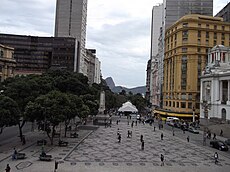You can help expand this article with text translated from the corresponding article in Portuguese. (January 2012) Click for important translation instructions.
|
22°54′39.63″S 43°10′32.61″W / 22.9110083°S 43.1757250°W / -22.9110083; -43.1757250





Cinelândia is the popular name of a major public square in the centre of Rio de Janeiro, Brazil. Its official name is Praça Floriano Peixoto, in honour of the second president of Brazil, Floriano Peixoto.
History
In colonial times, the main structure in the Cinelândia area was the Ajuda Convent, built for women around 1750. Today's square started to gain its current shape in the early 20th century, when the Brazilian government considered that Rio de Janeiro, then the capital of the Republic, needed to be completely overhauled.
Beginning in 1904, the centre of the city was remodeled following the latest trends in hygiene and urbanism under the direction of mayor Francisco Pereira Passos. The centrepiece of the reform was a large boulevard – the Avenida Central, now Avenida Rio Branco - which was built crossing the old city centre, passing by the Ajuda Convent. Most of the old colonial houses in central Rio were demolished. The area in front of the Ajuda Convent was turned into a public square.
During the early decades of the 20th century a series of monumental public buildings were built facing the square. These were the Municipal Theatre (Theatro Municipal), the Brazilian National Library (Biblioteca Nacional), the Rio de Janeiro Municipality (Palácio Pedro Ernesto) and the Higher Court (Tribunal Superior). Located nearby were the National Senate (Palácio Monroe, demolished in the 1970s) and the National School of Fine Arts, today Museu Nacional de Belas Artes. The square concentrated a great part of the political and cultural life of Brazil. The buildings surrounding the square, mostly following the French Beaux-Arts architectural style, were a symbol of the modernisation of the city.
In the centre of the square, a monument to Marshal Floriano Peixoto, second president of the Republic, was erected in 1910. The bronze monument, designed by sculptor Eduardo Sá and cast in France, depicts scenes of important events in Brazilian history. Another bronze statue, inaugurated in front of the Municipal Theatre, pays homage to Carlos Gomes, Brazil's foremost 19th century composer.
In 1979 a Rio de Janeiro Metro station was opened in the square. Cinelândia Station was one of the first five stations in the then-new network.
Cinemas
The old Ajuda Convent survived the initial remodeling of the square, but was finally demolished in 1911. In its place, Spanish entrepreneur Francisco Serrador built a series of tall buildings that concentrated the best cinemas of the city. It was due to these theatres that the area became popularly known as Cinelândia ("Cinema land").
Most of the cinemas are now closed, but the region around Cinelândia is still a lively spot in Rio thanks to its bars, restaurants and cultural attractions.
References
- "Cinelândia" (in Brazilian Portuguese). MetrôRio. Retrieved 17 September 2014.